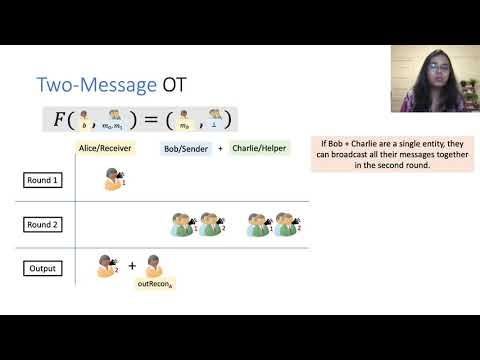CryptoDB
On Communication Models and Best-Achievable Security in Two-Round MPC
| Authors: | |
|---|---|
| Download: | |
| Abstract: | Recently, a sequence of works have made strong advances in two-round (i.e., round-optimal) secure multi-party computation (MPC). In the {\em honest-majority} setting -- the focus of this work -- Ananth et al. [CRYPTO'18, EC'19], Applebaum et al. [TCC'18, EC'19] and Garg et al. [TCC'18] have established the feasibility of general two-round MPC in standard communication models involving broadcast ($\BC$) and private point-to-point ($\PTP$) channels. In this work, we set out to understand what features of the communication model are necessary for these results, and more broadly the design of two-round MPC. Focusing our study on the plain model -- the most natural model for honest-majority MPC -- we obtain the following results: 1. {\bf Dishonest majority from Honest majority:} In the two round setting, honest-majority MPC and dishonest-majority MPC are surprisingly close, and often {\em equivalent}. This follows from our results that the former implies 2-message oblivious transfer, in many settings. (i) We show that without private point-to-point ($\PTP$) channels, i.e., when we use only broadcast ($\BC$) channels, {\em honest-majority MPC implies 2-message oblivious transfer}. (ii) Furthermore, this implication holds even when we use both $\PTP$ and $\BC$, provided that the MPC protocol is robust against ``fail-stop'' adversaries. 2. {\bf Best-Achievable Security:} While security with guaranteed output delivery (and even fairness) against malicious adversaries is impossible in two rounds, nothing is known with regards to the ``next best'' security notion, namely, security with identifiable abort (\IA). We show that \IA\ is also {\em impossible} to achieve with honest-majority even if we use both $\PTP$ and $\BC$ channels. However, if we replace $\PTP$ channels with a ``bare'' (i.e., untrusted) public-key infrastructure ($\PKI$), then even security with guaranteed output delivery (and hence $\IA$) is possible to achieve. \end{itemize} These results ``explain'' that the reliance on $\PTP$ channels (together with $\BC$) in the recent two-round protocols in the plain model was in fact {\em necessary}, and that these protocols {\em couldn't} have achieved a stronger security guarantee, namely, $\IA$. Overall, our results (put together with prior works) fully determine the best-achievable security for honest-majority MPC in different communication models in two rounds. As a consequence, they yield the following hierarchy of communication models: $\BC < \PTP < \BC+\PTP < \BC+\PKI$. This shows that $\BC$ channel is the {\em weakest} communication model, and that $\BC+\PKI$ model is strictly stronger than $\BC+\PTP$ model. |
Video from TCC 2021
BibTeX
@article{tcc-2021-31540,
title={On Communication Models and Best-Achievable Security in Two-Round MPC},
booktitle={Theory of Cryptography;19th International Conference},
publisher={Springer},
doi={10.1007/978-3-030-90453-1_4},
author={Aarushi Goel Rajeev Raghunath and Abhishek Jain and Manoj Prabhakaran and Rajeev Raghunath},
year=2021
}

